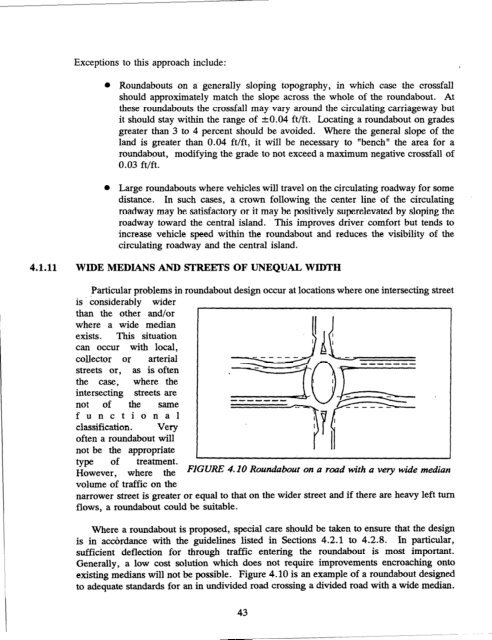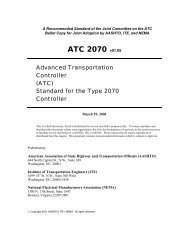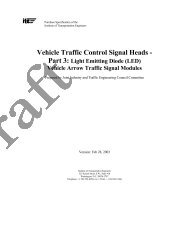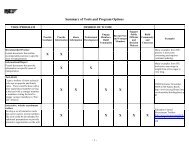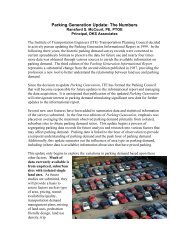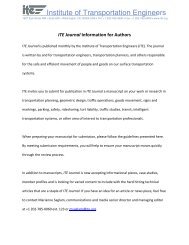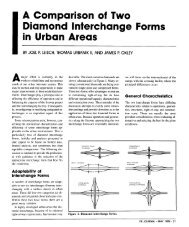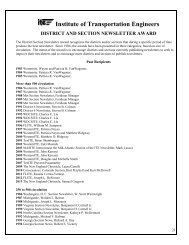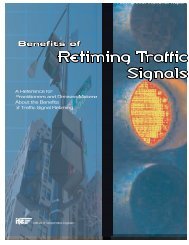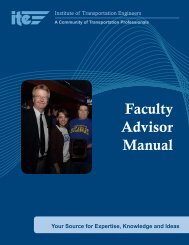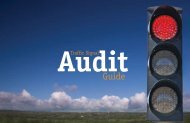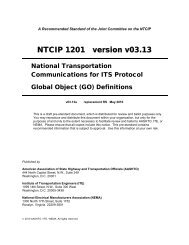roundabout ~' ~ design guidelines - Institute of Transportation ...
roundabout ~' ~ design guidelines - Institute of Transportation ...
roundabout ~' ~ design guidelines - Institute of Transportation ...
Create successful ePaper yourself
Turn your PDF publications into a flip-book with our unique Google optimized e-Paper software.
Exceptions to this approach include:<br />
0 Roundabouts on a generally sloping topography, in which case the crossfall<br />
should approximately match the slope across the whole <strong>of</strong> the <strong>roundabout</strong>. At<br />
these <strong>roundabout</strong>s the crossfall may vary around the circulating carriageway but<br />
it should stay within the range <strong>of</strong> 20.04 ft/ft. Locating a <strong>roundabout</strong> on grades<br />
greater than 3 to 4 percent should be avoided. Where the general slope <strong>of</strong> the<br />
land is greater than 0.04 ft/ft, it will be necessary to “bench” the area for a<br />
<strong>roundabout</strong>, modifying the grade to not exceed a maximum negative crossfall <strong>of</strong><br />
0.03 ft/ft.<br />
l<br />
Large <strong>roundabout</strong>s where vehicles will travel on the circulating roadway for some<br />
distance. In such cases, a crown following the center line <strong>of</strong> the circulating<br />
roadway may be satisfactory or it may be positively super-elevated by sloping the<br />
roadway toward the central island. This improves driver comfort but tends to<br />
increase vehicle speed within the <strong>roundabout</strong> and reduces the visibility <strong>of</strong> the<br />
circulating roadway and the central island.<br />
4.1.11 WIDE MEDIANS AND STREETS OF UNEQUAL WIDTH<br />
Particular problems in <strong>roundabout</strong> <strong>design</strong> occur at locations where one intersecting street<br />
is considerably wider<br />
than the other and/or<br />
where a wide median<br />
exists. This situation<br />
can occur with local,<br />
collector or arterial<br />
streets or, as is <strong>of</strong>ten<br />
the case, where the<br />
intersecting streets are<br />
not <strong>of</strong> the same<br />
functional<br />
classification. very<br />
<strong>of</strong>ten a <strong>roundabout</strong> will<br />
not be the appropriate<br />
type <strong>of</strong> treatment.<br />
However, where the FIGURE 4.10 Roundabout on a road with a very wide median<br />
volume <strong>of</strong> traffic on the<br />
narrower street is greater or equal to that on the wider street and if there are heavy left turn<br />
flows, a <strong>roundabout</strong> could be suitable.<br />
Where a <strong>roundabout</strong> is proposed, special care should be taken to ensure that the <strong>design</strong><br />
is in accordance with the <strong>guidelines</strong> listed in Sections 4.2.1 to 4.2.8. In particular,<br />
sufficient deflection for through traffic entering the <strong>roundabout</strong> is most important.<br />
Generally, a low cost solution which does not require improvements encroaching onto<br />
existing medians will not be possible. Figure 4.10 is an example <strong>of</strong> a <strong>roundabout</strong> <strong>design</strong>ed<br />
to adequate standards for an in undivided road crossing a divided road with a wide median.<br />
43


